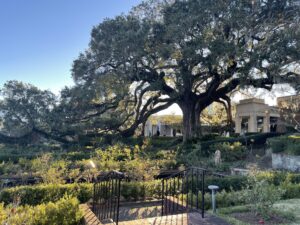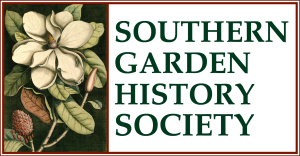
Credit: Victorialcoker, CC BY-SA 4.0 via Wikimedia Commons
SGHS members are particularly drawn to Ellen Biddle Shipman gardens. Although much of her work is found outside of our region, some of Shipman’s most acclaimed projects were in the South, such as Longue Vue, the subject of the second Gardens page post.
Thus, of real interest during the 2018 Jacksonville annual meeting was exploring her work within the larger designed landscape at the Cummer Museum of Art & Gardens. Offering Shipman insight was Judith Tankard, whose presentation drew from her 2008 publication A Legacy in Bloom: Celebrating a Century of Gardens at the Cummer and her then recent book Ellen Shipman and the American Garden. As the term “century” in the title of the first book might imply, several landscape professionals/firms were involved in the Jacksonville endeavors of the lumber-wealthy (first from Michigan forests and then from Florida woodlands) Wellington and Ada Cummer family. Their compound of three homes consisted of several acres in the Riverside neighborhood just west of the St. Johns River. Portions of this would ultimately become four distinct river-front garden spaces listed on the National Register in 2010.
Wellington Cummer’s son Arthur and, most particularly, Arthur’s wife Ninah initiated Jacksonville garden work, relying for initial overall direction on fellow Michigan native, landscape gardener, and teacher Ossian Cole Simonds.* A cofounder of the American Society of Landscape Architects, Simonds is especially known for cemetery design work, prairie school ties, and naturalistic installations. Realization of his concepts for the Cummer property (leaving live oaks and other natives as defining elements) commenced in 1903 with the first phases of installation of what is termed the English Garden.
Located in the Cummer Gardens’ southeast corner, the English Garden features a five-part formal plan with four shrub-edged parterres centered on a mosaic-tiled pool and a fountain defined by paired cherubs. Plantings would ultimately encompass roses, azaleas, and various herbaceous plants for seasonal color. Other distinct elements include a semi-circular wisteria arbor placed by the river and a southwest corner Tea Garden space. Beginning in 1910, Ninah would receive large numbers of plants from the Philadelphia nursery of Thomas Meehan & Sons, Meehan being noted for giving further form and filling in spaces outlined by Simonds.** (One can imagine the Meehan plants arriving via the regular steamship service that in these early years linked Jacksonville to Philadelphia and other northern cities.) Further guidance came from the increasingly prominent Florida horticulturist and educator, Harold Hume.
Arguably the best-known single “plant” in Ninah Cummer’s gardens is the Cummer Oak, estimated to be over four-hundred years old.*** This massive example of Quercus virginiana anchors an upper corner of the second named room here: the tiered lawn, also begun in 1903. Connecting the upper lawn tier to the grassy panel below is another signature feature of the tiered lawn, a set of curved stairs, each side fanning outward from top to bottom. Like the English Garden, this space terminates by the river in a semi-circle encompassing plant beds which extend to rectilinear beds bordering the grass-planted area (once a putting green) on either side.
North of the tiered lawn is Ellen Shipman’s acclaimed 1931 Italian Garden, her design showing the influence of an Arthur and Ninah Cummer visit to Italy’s Villa Gamberaia. Echoing features of this Florentine garden, Shipman’s design included a curved vine-covered pergola which enwraps semicircular rows of shrubs centered on a pool and a fine tripartite Italian fountain. Extending to the west, rectilinear pools flank a wide grass panel, while a slightly elevated terrace and brick wall on the north showcases a finely conceived planter designed by cast concrete and mosaic artist William Mercer. Multiple beds hosted a colorful plant array expressive of Shipman’s and Ninah Cummer’s tastes. Restoration work in recent decades has focused on returning Shipman-era color and form through azaleas, roses, dogwoods, and Italian cypress, to name but some of the material growing here.
The northernmost of the four Cummer landscaped zones is the Olmsted Garden, that name coming from work done there by William Lyman Phillips**** for Arthur’s brother Waldo and his wife Clara. Massachusetts-born and a Harvard landscape architecture graduate, Phillips was an Olmsted Brothers partner based in the Olmsted Lake Wales, Florida, office. Acquired by the Cummer Museum in the 1990s, the site has been the focus of twenty-first-century restoration efforts. Access to this garden comes from the Italian Garden and from an upper terrace via a curving stair down a steep slope. Principal features include a rectangular grass parterre centered on a bronze statue of Mercury and closed on the north with straight-line logia. This “Mercury” room neighbors grass panels with linear brick walks adjacent to the river.
Given this history of family dedication, with Ninah Cummer in the lead and professional input from various great names in the arena of American landscape design, it comes as little surprise The Cultural Landscape Foundation’s websites numbers these gardens as “among Florida’s most significant.” Special credit goes to that museum for its ongoing dedication to the “Gardens” half of their name, with all that entails, and the organization’s determination to restore them correctly after incurring the major hurricane damage which so often affects that region.
***********************************************************
For more on the Cummer Gardens, visit: https://www.cummermuseum.org/cummer-museum-gardens/
*https://www.tclf.org/oc-simonds-biography
** https://www.tclf.org/pioneer/thomas-meehan-and-sons
***https://www.tclf.org/sites/default/files/microsites/everytree/cummeroak.html

Leave a Reply